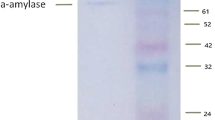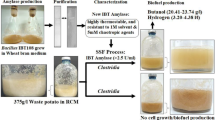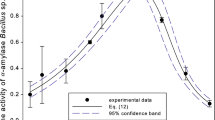Abstract
The purified acidic α-amylase of Bacillus acidicola is a monomer of 66.0 kDa, optimally active at pH 4.0 and 60 °C. The enzyme is Ca2+ independent with T 1/2 for 18 min at 80 °C. The K m, V max, and catalytic efficiency (k cat/K m) of the enzyme are 1.6 mg mL−1, 23.8 μmol mg−1 min−1, and 981 μmol s−1, respectively. Among detergents, Tween 20, 40, and 80 stimulated enzyme activity, whereas sodium dodecyl sulfate and Triton X-100 inhibited even at low concentration. EGTA has not affected the activity, whereas EDTA β-mercaptoethanol, iodoacetic acid, and Dithiothreitol exhibited a slight inhibitory action. Phenylmethanesulfonyl fluoride, N-bromosuccinimide, and Hg2+ strongly inhibited enzyme activity. The experimental activation energy and temperature quotient are 50.12 kJ mol−1 and 1.37. When thermodynamic parameters (ΔH and ΔS) of the enzyme have been determined at different temperatures, ΔG is positive suggesting that the enzyme is thermostable. The enzyme hydrolyzes raw starches, and therefore, the enzyme finds application in raw starch saccharification at sub-gelatinization temperatures that saves energy needed for gelatinization of raw starch at 105 °C.



Similar content being viewed by others
References
Sanchez, S., & Demain, A. L. (2010). Organic Process Research & Development, 15, 224–230.
Rao, M. B., Tanksale, A. M., Gathe, M. S., & Deshpande, V. V. (1998). Microbiology and Molecular Biology Reviews, 62(3), 597–635.
Sharma, A., & Satyanarayana, T. (2010). Biotechnology Letters, 32, 1503–1507.
Sharma, A., & Satyanarayana, T. (2012). Extremophiles, 16, 515–522.
Sharma, A., & Satyanarayana, T. (2011). Journal of Bioscience and Bioengineering, 111, 550–553.
Lowry, O. H., Rosebrough, N. J., Farr, A. L., & Randall, R. J. (1951). Journal of Biological Chemistry, 193, 265–275.
Laemmli, U. K. (1970). Nature, 227, 680–685.
Kapat, A., & Panda, T. (1997). Bioprocess and Biosystems Engineering, 16, 269–272.
Gohel, V., & Naseby, D. C. (2007). Biochemical Engineering Journal, 16, 57–67.
Ali, M. B., Mhiri, S., Mezghani, M., & Bejar, S. (2001). Enzyme and Microbial Technology, 28, 537–542.
Aguilar, G., Morlon-Guyot, J., Trejo-Aguilar, B., & Guyot, J. P. (2000). Enzyme and Microbial Technology, 27, 406–413.
Mehta, D., & Satyanarayana, T. (2013). Journal of Molecular Catalysis B: Enzymatic, 85–86, 229–238.
Prieto, J. A., Bort, B. R., Martinez, J., Randez-Gil, F., Buesa, C., & Sanz, P. (1995). Biochemistry and Cell Biology, 73, 41–49.
Manning, G. B., & Campbell, L. L. (1961). Journal of Biological Chemistry, 236, 2952–2957.
Bai, Y., Huang, H., Meng, K., Shi, P., Yang, P., Luo, H., et al. (2012). Food Chemistry, 131, 1473–1478.
Nguyen, Q. D., Judit, M., Szabo, R., Claeyssens, M., Stals, I., & Hoschke, A. (2002). Enzyme and Microbial Technology, 31, 345–352.
Asoodeh, A., Chamani, J., & Lagzian, M. (2010). International Journal of Biological Macromolecules, 46, 289–297.
Savchenko, A., Vieille, C., Kang, S., & Zeikus, G. (2002). Biochemistry, 41, 6193–6201.
Ali, M. B., Mezghani, M., & Bejar, S. (1999). Enzyme and Microbial Technology, 24, 584–589.
Robyt, J., & Ackerman, R. J. (1971). Archives of Biochemistry and Biophysics, 145, 105–114.
Fogarty, W. M., & Kelly, C. T. (1980). In A. H. Rose (Ed.), Microbial Enzymes and Bioconversions (pp. 115–170). London: Academic Press.
Chary, S. J., & Reddy, S. M. (1985). Folia Microbiologica, 30, 452–457.
Giri, N. Y., Mohan, A. R., Rao, L. V., & Rao, C. P. (1990). Current Science, 59, 1339–1340.
Dey, G., Palit, S., Banerjee, R., & Maiti, B. R. J. (2002). Industrial Microbiology and Biotechnology, 28, 193–200.
Liu, W., Shi, P., Chen, Q., Yang, P., Wang, G., Wang, Y., et al. (2010). Applied Biochemistry and Biotechnology, 162, 1–12.
Kumar, V., & Satyanarayana, T. (2011). Biotechnology Letters, 33, 2279–2285.
Singh, B., & Satyanarayana, T. (2009). Bioresource Technology, 100, 2046–51.
Bai, Y., Huang, H., Meng, K., Shi, P., Yang, P., Luo, H., et al. (2012). Food Chemistry, 131, 1473–1478.
Kapoor, M., Beg, Q. K., Bhushan, B., Dadhich, K. S., & Hoondal, G. S. (2000). Process Biochemistry, 36, 467–473.
Perez-Pomares, F., Bautista, V., Ferrer, J., Pir, C., Marhuendra-Egea, F. C., & Bonete, M. J. (2003). Extremophiles, 7, 299–306.
Antranikian, G. (1992). In: Winkelmann (Ed.), Microbial degradation of natural products (pp. 27–56). Weinheim, Germany: VCH.
Liu, B., Wang, Y., & Zhang, X. (2006). Enzyme and Microbial Technology, 39, 805–810.
Ballschmiter, M., Futterer, O., & Liebl, W. (2006). Applied and Environmental Microbiology, 72, 2206–2211.
Rao, J. L. U. M., & Satyanarayana, T. (2007). Applied Biochemistry and Biotechnology, 142, 179–193.
Paoli, P., Fiaschi, T., Cirri, P., Camici, G., Manao, G., Cappugi, G., et al. (1997). Biochemistry Journal, 328, 855–861.
Chauthaiwale, J., & Rao, M. (1994). Biochemistry Biophysica Acta, 1204, 164–168.
Komissarov, A. A., Romanova, D. V., & Debabov, V. G. (1995). Journal of Biological Chemistry, 270, 10050–10055.
Asoodeh, A., Chamani, J., & Lagzian, M. (2010). International Journal of Biological Macromolecules, 46, 289–297.
Spencer-Martins, I., & Van Uden, N. (1979). European Journal of Applied Microbiology and Biotechnology, 6, 241–250.
Kanno, M. (1986). Agricultural and Biological Chemistry, 50, 2633–2635.
Bernfeld, P. (1955). In: I. S. P. Colowich, & N. O. Kaplan (Eds.), Methods in enzymology (pp. 149–158). New York: Academic.
Maisuria, V. B., Patel, V. A., & Nerurkar, A. S. (2010). Journal of Microbiology and Biotechnology, 20, 1077–85.
Kolawole, A. O., Ajele, J. O., & Sirdeshmukh, R. (2011). Process Biochemistry, 46, 2178–86.
Muhammad, R., Raheela, P., Muhammad, J., Habibullah, N., & Muhammad, H. R. (2007). Enzyme and Microbial Technology, 41, 558–64.
Kikani, B. A., & Singh, S. P. (2012). Process Biochemistry, 47, 1791–1798.
Gubern, G., Canalias, F., Gella, F. J., Colinet, E., Profilis, C., Calam, H., et al. (1996). Clinica Chimica Acta, 252, 145–162.
Acknowledgments
The authors gratefully acknowledge financial assistance from the Department of Science and Technology (DST) and Council of Scientific and Industrial Research (CSIR), Government of India, New Delhi during the course of this investigation.
Author information
Authors and Affiliations
Corresponding author
Rights and permissions
About this article
Cite this article
Sharma, A., Satyanarayana, T. Characteristics of a High Maltose-Forming, Acid-Stable, and Ca2+-Independent α-amylase of the Acidophilic Bacillus acidicola . Appl Biochem Biotechnol 171, 2053–2064 (2013). https://doi.org/10.1007/s12010-013-0501-y
Received:
Accepted:
Published:
Issue Date:
DOI: https://doi.org/10.1007/s12010-013-0501-y




